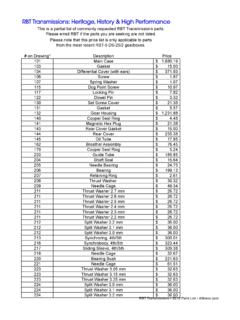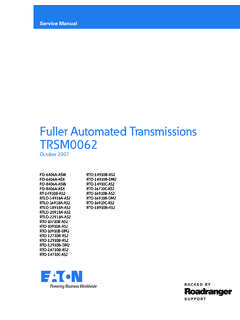Transcription of Ford’s First Automatic Transmission: The Story …
1 250 Years of Ford Automatic TransmissionsDecember, 2001On the heels of World War II, America and Americans returned to living. As the country switched from wartime to peacetime, there came a torrent of new consumer goods. These inventions and adaptations reflected the welcome change from a military to a civilian economy. America was ride-hungry and car-happy and manufacturers vied with each other to produce cars that would take people wherever they wanted to go faster, cheaper, and smoother. Out of this fiercely competitive market came many new developments to make driving easier and safer. The single most important of these was the Automatic had marketed the First fully Automatic transmissions , called Hydramatic, in selected 1940 models. Buick launched its Dynaflow in 1948, as did Studebaker with its Commander. Packard introduced its Ultramatic in 1949.
2 By all indications, Ford was late to this party. Ford Engineering Vice President Harold Youngren was tasked with doing something about it. Having been hired away from independent transmission maker Borg-War-ner, he wasted no time recommending to Ford that it license the very Automatic transmission he had been working on when he left Borg. Tested extensively for durability and performance, it was pronounced superior to any other unit on the market. In the opinion of Ford engineers, this transmis-sion was the answer to the Company s noncompetitiveness the fall of 1948, long-term contracts were drawn up with Borg. Borg would fill half of Ford s anticipated Automatic transmission needs for a period of five years, and Ford would be responsible to either make Ford s First Automatic Transmission: The Story Behind the Storythe other 50% or subsource it elsewhere.
3 Shortly afterwards, Ford broke ground in Cincinnati for a new plant to manufacture automatics. The Fairfax facility opened in the 1951 model year was introduced to the public, Ford-made Automatic transmissions Fordomatic and Mercomatic were available for the First time. While initial volumes were small (Ford sold 11,135 units in MY 1951; Mercury sold another 7800), they climbed public approved. Enthusiasts recognized two distinct advantages to the Fordomatic prod-uct: 1) its inherent shift smoothness (due to influ-ence of an integrated torque converter) and 2) its (then) radical d tente/PRNDL placement, which put reverse next to park, and safely out of the way of inadvertent access! (Elsewhere in industry, the gear pattern was P-D-N-L-R.) In making this technical leap to the Automatic transmission in 1951, Ford belatedly caught a wave of customer preference.
4 What was a mere wave in 1951 would become an overwhelming customer mandate, and the Company would ride it from that point brief, anecdotal history of the First 50 years of Ford Automatic transmissions is dedicated to the thousands of men and women who have made Ford s Automatic Transmission business a success. Their talents, creativity, and dedication have contributed to making Ford Motor Company a leading world have been many who have contributed to this anecdotal history of Ford s First 50 years of Automatic transmission design and development. Through their suggestions, recall, viewpoints, enthusiasm, and written contributions, they have made this retrospective among them are active employees Matt Lee, Bob Roethler, Tom Greene, Bruce Palansky, Paul Erlandson,Joe Sprys, Sandell Bennett, and Walt Muench. I am also indebted to outside author Philip Gott, whose excellentChanging Gears (SAE Press, 1991) is the authoritative history of Automatic transmission resources and information have come from Borg Warner, the City of Romulus, the Historical Society of the City of Cincinnati, and the National Automotive Historical Collection of the Detroit Public Library.
5 The project has also received wonderful assistance from Ford s Industrial Archives (Sandy Bialic, Bonnie Walworth & Jamie Myler), Ford Photographic (Dan Erickson), and Ford Creative Services (Chris Szetela).Finally, the enthusiastic contributions of transmission retirees have been indispensable. I am particularly grateful to Karl Bornemann andLarry Burcz, and pleased to have had the counsel of Andy Paredes,Burt Jones, Sam Dabich, Clyde Juntunen, Stan Rosen, Marty Gabriel,Bruce Stapleton, John Schramm, Bob Thom, Stuart Maxwell, Frank Abar,Dick Byler, Paul Roberts, Bruce Simpson, Marge Lyons, and Jan & Thanks Mike Imirie, Editor / ATEO CommunicationsContributing retirees: 220 years of Ford service!December, 2001350 Years of Ford Automatic TransmissionsAutomatic Transmission Engineering OperationsIn the early days of the automobile, the driver wore gloves, goggles and a long coat called a duster because the roads were dusty and handling the car was rough work.
6 The toughest jobs back then involved keeping the motor keeping the vehicle moving! Keeping the motor running meant manually manipulating carburetor adjustments, speed controls, and ignition timing. Keeping the car moving meant working a clutch and manually picking an appropriate gear ratio to match road 1904, The Sturdevant brothers of Boston devised a system which automatically shifted the vehicle from low to high gear at 6 miles per hour. This was a great advance, but the shift always took place at the same speed whether the vehicle was going uphill, downhill, or on flat land. At that same time, others manufacturers were playing with planetary gear sets needing a manual apply but allowed flexibility of gear selection based on road or load conditions. The most noted of these almost Automatic transmis-sions was the planetary gear transmission used in the Model T Ford between 1908 and 1927.
7 The use of pedal-controlled planetary gears made the Model T the go anywhere car. When mired in mud or snow, the car could be rocked free without clash-ing the gears, for low, high, and reverse were all functions of the planetary gear set. In all, over 15 million model T s were sold. Incredibly easy to drive by the standards of the day, the Model T was so pop-ular that by 1925 one half of the cars on the road were in manual transmissions forced Ford to adopt what Ol Henry called clash-gear transmissions for a while. But automotive engineers remained fascinated by the possibility of self-shifters, and transmission developments continued in each succeeding the early 1930 s, an independent maker named REO most famous for its line of Speedwagon trucks developed a self-shifter transmission. The REO unit was the First truly Automatic transmission.
8 There was a clutch for stopping or reverse but all forward drive ranges were Automatic . By the late 1930 s, GM marketed the Oldsmobile Safety Transmission that eliminated the clutch. Due to engineering issues, it was only produced for two 1940 s brought shifting innovations by Hudson, Packard, General Motors, and Borg Warner. Ford Motor Company kept a close watch in the development of the Automatic transmission and decided to adopt a Borg design for the Ford/Mercury product lines and the GM s Hydra-Matic for in 1950, Ford s Fairfax Plant (near Cincinnati) was chosen for initial transmission develop-ment and production of the First Automatic transmission ( Fordomatic ). Early in the decade, Ford engi-neers strengthened and modified the unit for all Ford Motor Company applications. As horsepower increased and model proliferation expanded, Ford Automatic transmissions met the demand for shifting with Matt Lee, Service EngineeringShifting with Ease: The Early DaysFord reached the milestone of 750,000 transmissions in the early days of 1954450 Years of Ford Automatic TransmissionsDecember, 2001 History is more or less bunk.
9 May be Henry Ford s most famous quote, but this founder of Ford Motor Company also built the Henry Ford Museum and Greenfield Village. He believed that one can best move forward if one is aware and respectful of his/her ori-gins. It is therefore appropriate during the 50th anniversary celebration of Ford s auto-matic transmission operations to reflect on the past in order to move ahead with the efficiency, strength and knowledge that comes from understanding the heritage of the 1951 Fordomatic Ford s First involvement with Automatic transmissions ? Ford actually worked with Borg Warner to develop two earlier Automatic transmissions in answer to the two-pedal driving enabled by transmissions from General Motors and Chrysler. For the 1942 model year, Ford worked with Borg to offer the Liquamatic Drive in the Mercury and Lincoln lines.
10 Today this unit would be called a semi- Automatic transmission: a robot-ized manual. It used a fluid coupling between the engine flywheel and a conventional clutch. It could be driven with the gear shift in high or 3rd gear position, but would start from a stop in second gear. It used a vacuum-powered actua-tor to upshift from 2nd and 3rd when the driver s foot lifted from the throttle, momentarily reducing driveline torque. Liquamatic was the First trans-mission to use the tang-in-slot method of con-structing a fluid coupling or a torque the 1947 model year, Ford was ready to offer another Automatic transmission, the Liver-more Automatic Layshaft Transmission. This Borg Warner development used a conventional coun-tershaft layout, with a centrifugal wet-clutch for start up. Torque was interrupted by an auto-matic throttle-closer (forerunner of drive-by-wire in 1946!)







